Eggnog Drink and How to Avoid Food Waste
Looks like it’s that time of year again, Christmas eggnog time. It’s the perfect occasion for the rich, thick and decadent drink that you either love or hate. As we prepare for family gatherings, decorating the tree and midnight mass, let’s dive into the origin story of this drink, find out why it is associated with Christmas, and discover the wildest eggnog anecdotes. We will also show you creative ways to use your leftover drink and avoid food waste. So pour yourself a glass, get into the Christmas spirit, and if no one’s looking, spike it with a little something. Let’s go!
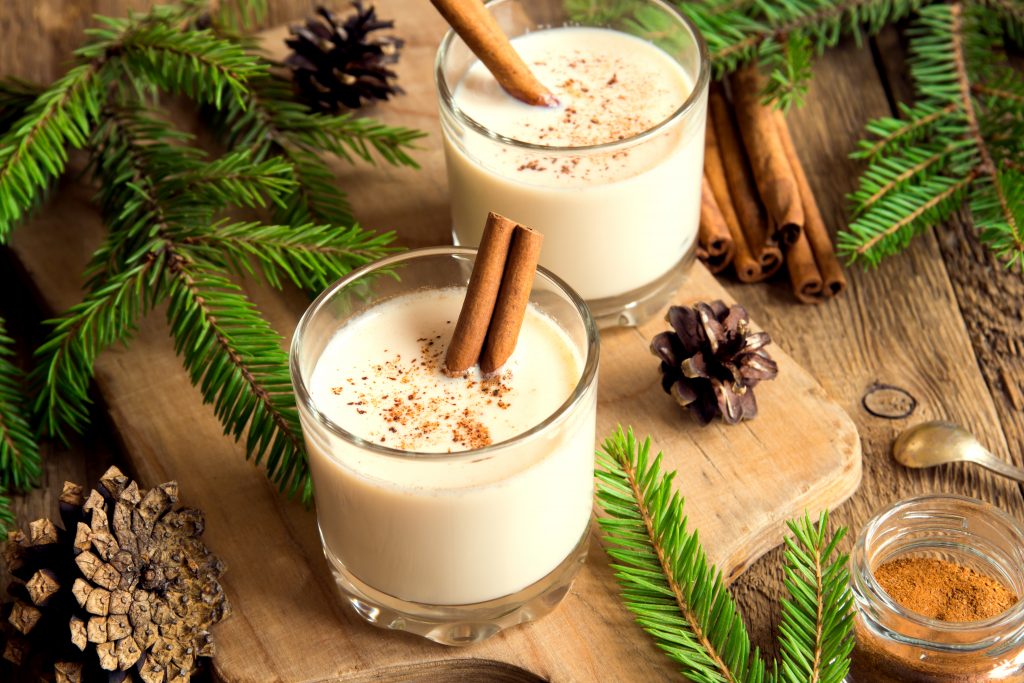
Eggnog Origin
To start off, the eggnog drink has a rather old and unclear beginning. Historians often go all the way back to Medieval-era Britain to pinpoint the first iterations of this holiday favourite. Its first version used to be called “posset”, a hot, milky and ale-like beverage. Originally not consumed during celebration, it was used as a cold and flu remedy. Just like we drink hot water with honey and lemon these days, sickly medieval Brits had posset.
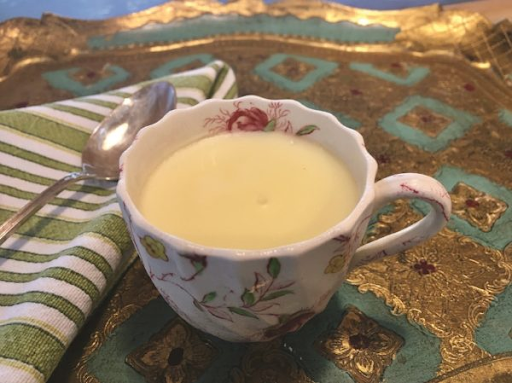
A Citrusy Cool Posset for a Hot Summer Night (The Provincetown Independent/Teresa Parker)
People slowly caught on to posset’s potential and started experimenting. By the 13th century, monks would drink posset with added eggs and figs. That already sounds pretty tasty. Better yet, the wealthier classes would add milk, eggs and sherry to this drink, creating a drink similar to the eggnog we know and love (or sometimes not) today. However, this drink, at the time, was only available to the aristocracy.
And what about the name itself, “eggnog”? It doesn’t sound like any other word, and what is “nog” anyway? Well, we have some clues, but we aren’t sure of the exact meaning. For example, some say “nog” comes from the word “noggin”, a sort of wooden drinking cup. It could also come from “grog”, an Old English word for strong beer. Or in some cases rum, which would make sense since this drink is a combination of posset, egg and alcohol.
According to Merriam-Webster, “nog” was a “strong ale formerly brewed in Norfolk, England”. Some historians even argue that the term “nog” is a combination of the 2 terms: rum, referred to a nog or grog, would sometimes be served in the small wooden cups, noggins. In any case, the 2 words stuck together (as if bound together by the sticky drink itself) resulting in “eggnog”.
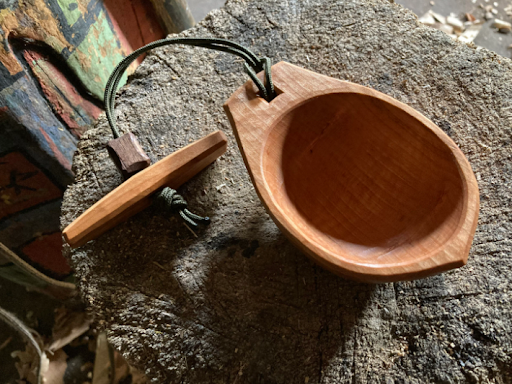
A noggin cup (Klipnocky Woods)
Jumping a few centuries forward, this concoction crossed the ocean in the 17th century and spread across America. This was due to England and America’s shared anglo-saxon heritage, but also to some specific factors of the time: In America, Caribbean rum was a cheap ingredient, partly since it wasn’t as heavily taxed as wine or brandy. Also, the colonial system of the time used slaves to produce rum in the Caribbean, making it a cheap alternative in the region. Combining farms loaded with egg-laying chickens with the need to preserve food for the winter time, it becomes clear why this homemade alcoholic sugary drink seemed like an obvious choice for Christmas.
Why is Eggnog a Christmas Drink?
For starters, it became popular around Christmas time because of its warm temperature and the addition of seasonal flavours such as nutmeg, cinnamon and vanilla. While these ingredients were available year-round, could you imagine colonial Americans drinking a hot, rich and syrupy drink in the peak of summer after ploughing a field? It made much more sense to wait until winter and celebrate the end of harvest in front of a warm fire and a cup of nog.
This reason in itself could already explain the association, but there’s also a historical side to it: During the American Revolutionary War, rum suddenly became much more scarce. Therefore, since that was the alcohol used for eggnog, they would save it for a special occasion. In the end, this meant saving eggnog ingredients for Christmas. Combine this factor with eggnog’s celebratory aura and its popularity during wintertime, and you now have a Christmas drink etched in stone!
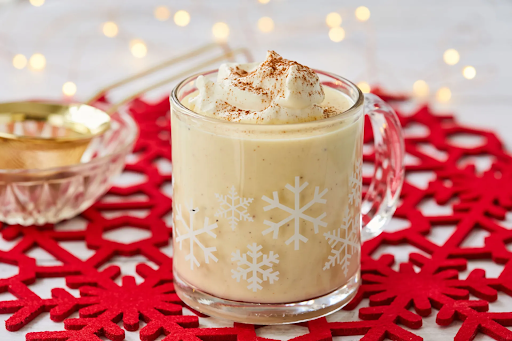
A creamy cup of eggnog topped with cinnamon (Big Bolder Baking)
Eggnog Stories
Records show that George Washington, the first president of the US, served a similar drink to guests, although much more loaded with spirits, such as rye, whisky, rum and sherry. He even wrote down his own recipe, which you can follow yourself to get a taste of the era. Here it is: “One quart cream, one quart milk, one dozen tablespoons sugar, one pint brandy, 1/2 pint rye whiskey, 1/2 pint Jamaica rum, [and] 1/4 pint sherry.” The recipe instructs cooks to “mix [the] liquor first, then separate yolks and whites of eggs, add sugar to beaten yolks, mix well. Add milk and cream, slowly beating. Beat whites of eggs until stiff and fold slowly into mixture. Let set in cool place for several days. Taste frequently.” The recipe did not specify the number of eggs, though modern chefs estimate a dozen eggs will do the job.
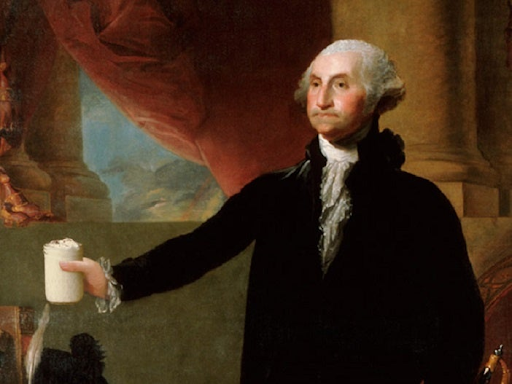
George Washington recipe for eggnog (We are the mighty)
As the 1800s went on, the popularity of eggnog spread like wildfire, even to the highest offices of the State. On December 31, 1859, an editorial in “The Chicago Press and Tribune,” noted how even politicians in the U.S. House of Representatives could not resist eggnog’s charms. “Eggnog has ruled the country today,” it said. “It is a famous drink in public and private houses in Washington on Christmas, and some of the members, in spite of it, reached the house today at noon, and some, in consequence of it, did not get there at all.”
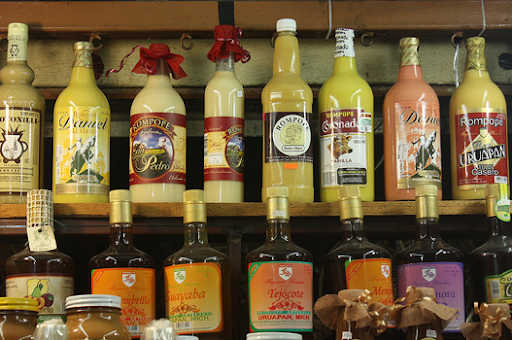
Bottles of Rompope sitting on a shelf (Food Republic)
Later on, Eggnog took a hit during the Prohibition era in the US (although became paradoxically more popular, due to its newfound status as a forbidden fruit), but made a comeback afterwards. In the 1940s it started showing up in supermarkets, some with alcohol, some without, and in the 1960s that it became a mainstream, mass-produced drink during Christmas time. Nowadays, eggnog is consumed mostly in the anglo-saxon world, primarily the US, Canada and the UK. While not as popular in Australia and New-Zealand, taking into consideration the questionable experience of drinking this delicious drink during the summer. There is a similar traditional drink in Central America (Mexico primarily, but also Honduras, Costa Rica, Ecuador, Nicaragua, El Salvador, Guatemala and Belize) called Rompope, made with eggs, milk, vanilla and rum. The yolks used give it a particularly yellow hue. Also, coquito is a coconut-based Christmas alcoholic beverage enjoyed this time of year in Puerto Rico.
Posset’s and eggnog’s popularity also extended to other countries. In France, for example, posset has more than once almost graced the lips of kings. In 1270, on his deathbed, king and saint Louis IX was prescribed a glass (or rather, a noggin) of posset by his doctors. However, famously religious as he was, he refused to drink it, as it was during a period of fasting. Interestingly, the same exact situation occurred in the case of king Philip IV, in 1314. Who knows, maybe this strange concoction would have saved them.
Following the transformation of posset into eggnog, the latter enjoyed great popularity in 19th century France, for its reputation of stimulating strength and appetite. Eggnog is actually mentioned many times in French works of fiction. For example, it appears in Guy de Maupassant’s Boule de suif, and even in Gustave Flaubert’s masterpiece, Madame Bovary.
These days, it appears in supermarkets during Christmas time, alcohol free. You can enjoy it with the whole family or, if you’re hosting a wild Christmas party, enhance it (ideally in a responsible proportion) with alcohol like rum or brandy.
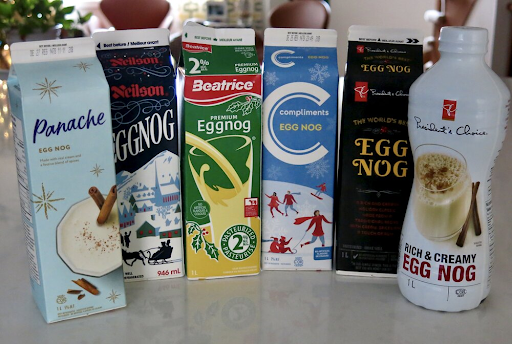
Eggnog taste test (Brian Fancis)
The 1826 Eggnog Riot and the Mexican Prison-Style Eggnog
Did you know that eggnog caused a major riot in America’s most prestigious military school? It happened over Christmas 1826, in West Point Academy. Earlier in the year, the Superintendent of West Point, Colonel Sylvanus Thayer, had banned all alcohol from the premises. Nevertheless, that didn’t dissuade the more intrepid students: Cadets smuggled tons of whisky into the school grounds to make homemade eggnog for a huge Christmas party.
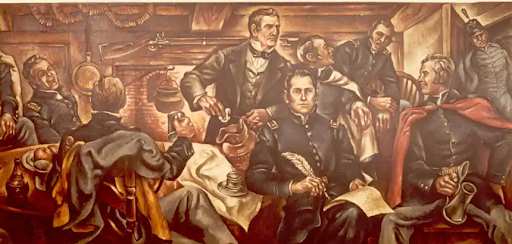
The West Point Academy was a chaos scene over eggnog in 1826 (CBS)
Far from a fun gathering, the result was pure chaos. Over Christmas Eve, an estimated 90 cadets, or one third of the whole school, took part in a wild party, getting totally drunk and rioted, resulting in broken dishware, furniture, windows, torn barristers and even in the assault of 2 officers! What on earth did they put in that eggnog? A month later, the school severely reprimanded 70 students, court martialing the 20 worst offenders and fully expelling 11 of them. This incident later became known as the Eggnog Riot, or the Grog Mutiny. We recommend sticking with the usual store-bought kind, or at least not spiking your homemade eggnog to the extent these cadets did.
Also related to the military, there is a story of a Mexican-style eggnog made, not in a cadet school, but in prison: In April 1843, during a border raid, Mexican General Santa Anna captured some members of the Army of the Texas Republic, and threw them in prison. Meanwhile, during their imprisonment, one day came the anniversary of their victory at the Battle of San Jacinto, during which the Texan army decisively defeated the Mexicans, in 1836. Not discouraged by their less than festive setting, they managed to steal some kitchenware and bribe prison guards to smuggle in mezcal, sugar, eggs and donkey’s milk. After the soldiers mixed up this drink, their leader, General Thomas Green, declared the concoction a resounding success. He even asserted that “such egg-nog as never was seen or drank under the nineteenth degree of northern latitude.” We can only respect these men’s determination to have their eggnog, even in the confines of a prison cell!
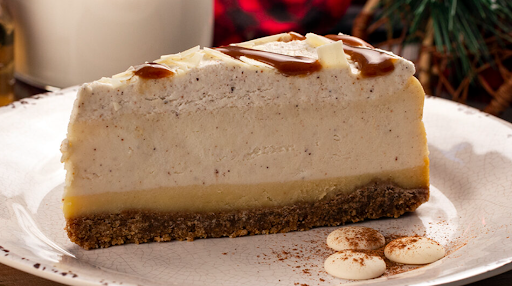
Buttered rum caramel eggnog cheesecake (Wow! Factor Desserts)
Eggnog Desserts
Now, let’s say you hosted a Christmas bash, everybody had their fill of drinks and desserts, and once everybody left, you noticed that you had prepared way more eggnog than people ended up drinking. Maybe you had more eggnog naysayers among your guests than you expected, or everybody got filled up on a Christmas yule log. What are you going to do with all this leftover eggnog, especially if you don’t feel like drinking it all yourself?

Eggnog latte (Caffe Calabria)
Since eggnog is basically a sweet and spiced pancake batter, you can add it to many kinds of desserts to give it a Christmas flavour. Here is a shortlist of eggnog desserts:
- French toast/bread pudding – use sweet bread, like Challah bread and dunk it in eggnog.
- Icing – Combine eggnog leftovers with confectioners’ sugar and pour it over any fresh pastry.
- Coffee/latte – Just blend the eggnog until it is foamy and add it to your latte.
- Cakes/pies/muffins/cupcakes/loaf/scones – Instead of using heavy cream or milk, replace it with eggnog.
- Waffles/ pancake – Use eggnog as the batter or mix it with maple syrup.
- Rice pudding/oatmeal – Instead of water based, use eggnog.

Eggnog pie (The Rolling Pin)
Food waste in Canada
Christmas is a great time for celebration and feasting on warm, hearty meals. But it is also the time to think about those who aren’t as fortunate as us, and to practice generosity. This includes, for example, thinking of food that we don’t consume and end up throwing away.
In Canada, food waste is substantial and becoming a concerning problem. As an example, a staggering 58% of food produced in Canada is lost or wasted each year, according to research by Waste Reduction Week in Canada. Consequently, landfills of food end up creating over 56 million tonnes of carbon dioxide-equivalent emissions by emitting methane, a greenhouse gas. On top of that, this does not take into account the resources used to make the food itself, such as water, soil, pesticides, animal feed, and the energy required to produce and transport it.
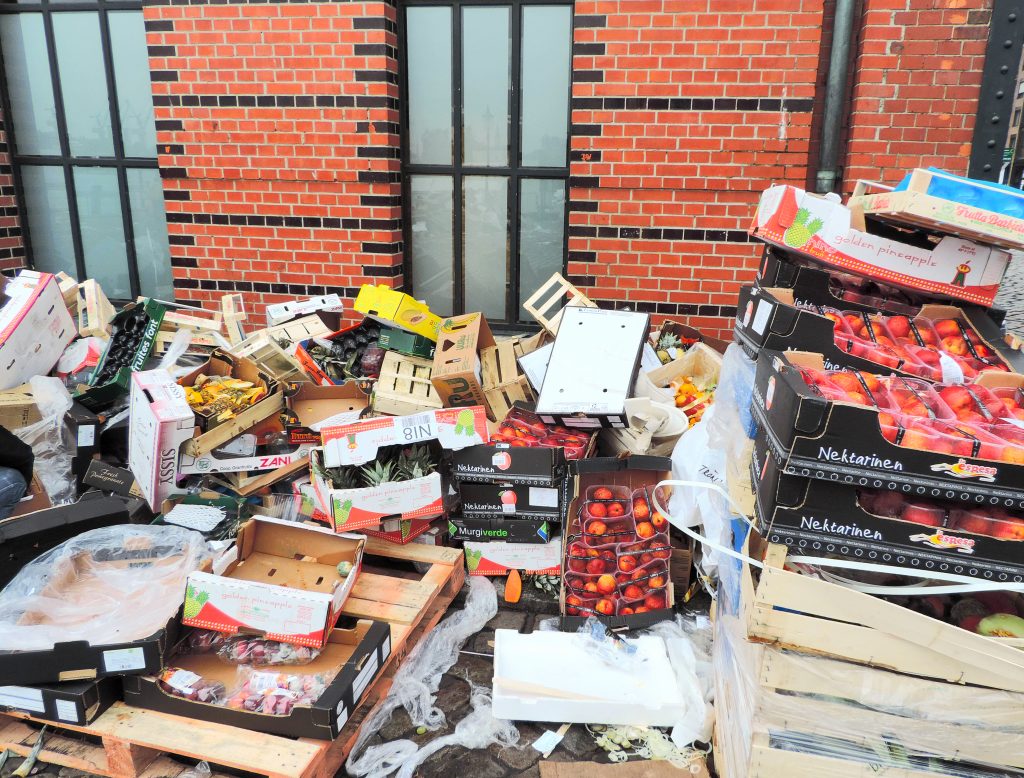
Piles of food waste outside a restaurant
Economy-wise, the average Canadian spends $1,766 a year on food that is wasted. Food waste costs the country’s economy $49 billion a year. According to Made In CA, saving just a quarter of food lost or wasted globally each year would feed 870 million people. Also, 47% of food waste in Canada is generated at the household level. There are many reasons for food waste. Some of them include overbuying, stocking too much food that spoils before it can be sold or eaten, improper storage or packaging conditions that lead to food spoilage/ contamination. Also, overproduction of food and throwing away unsold products contribute to the waste problem.
While these are worrying statistics, the fact that half of the waste comes from the household means that each one of us can make a difference. Businesses and governments of course have roles to play as well. Redirecting or rescuing surplus edible food could save 3.82 tonnes of greenhouse gas emissions per tonne of food. According to the Canadian government, there are 3 main ways to fight food waste on a household level:
- Reduce: Be sure to plan your meals before you shop so that you only buy what you can consume before it spoils and ends up in the garbage
- Recover: Donate to food programs that help people in your community
- Recycle: Participate in organic waste collection programs or start a composter in your backyard and use the Greenhouse Gas Calculator for Waste Management to estimate the reduced emissions resulting from it.
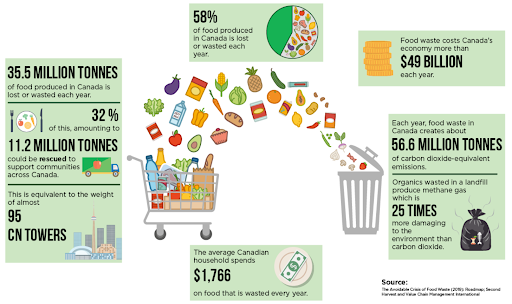
Canada’s food waste situation summed up in a few statistics
(Waste Reduction Week in Canada)
As the weather cools down and snow piles up, we hope this blog has put you in the mood for a rich and creamy glass of eggnog drink, or for a decadent eggnog dessert. Remember, every bit of generosity and effort to reduce waste go a long way. On that note, enjoy the eggnog, and merry Christmas!




